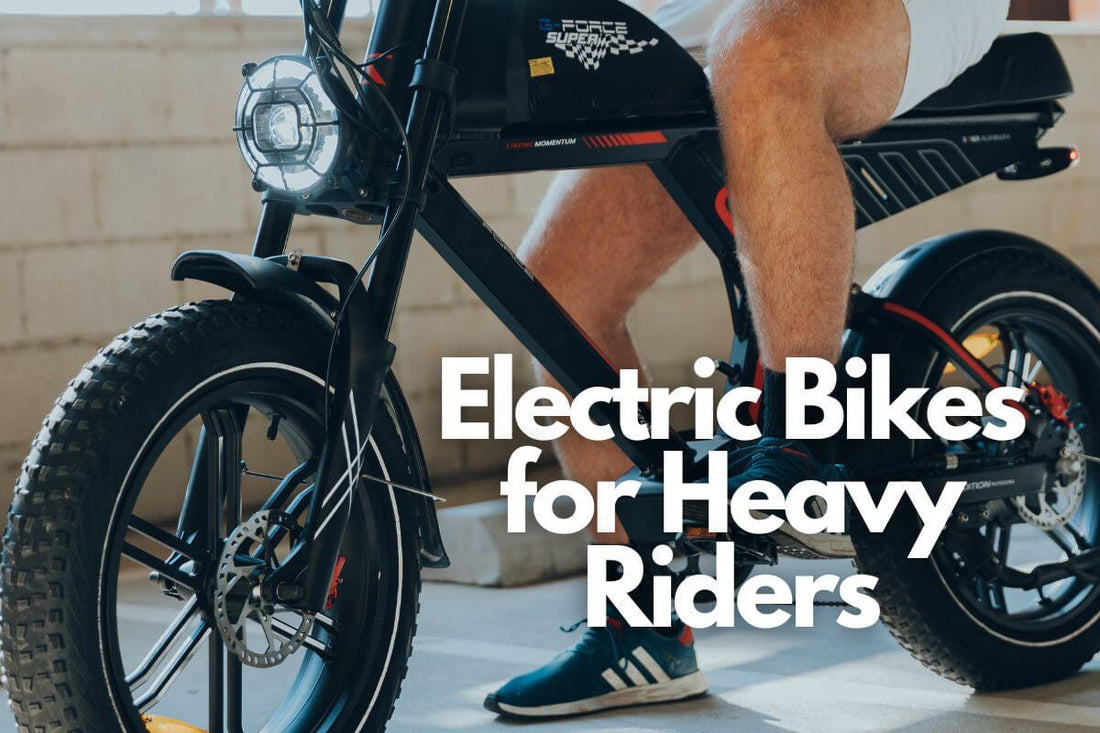
Best Electric Bikes for Heavy Riders in the UK (2025 Buying Guide)
Share
Finding an electric bike that fits your needs as a heavy rider can be tough. Many models don’t offer the right frame strength or motor power.
The best electric bikes for heavy riders in the UK combine strong build quality, high weight limits, and reliable motors to give you a smooth and safe ride.
You want a bike that handles your weight without strain and still offers good battery life and comfort.
Models designed for heavier riders often have reinforced frames, wider tires, and powerful motors that tackle hills easily.
This guide will help you find options that meet these needs in 2025.
Knowing what to look for saves time and ensures you get the right bike for your lifestyle.
Whether you want to commute or enjoy weekend rides, the right electric bike can make all the difference in your experience.
What To Look For When Choosing E-Bike for Heavier Riders
Focus on the bike’s frame size, comfort adjustments, and tire options to ensure durability and a smooth ride.
These factors directly affect safety, control, and how well the bike supports your weight.
Choosing the Right Frame Size
Select a frame size that matches your height and riding style. A frame that’s too small puts strain on your joints and feels unstable.
Too large, and you lose control and comfort.
Look for a frame made from strong materials like reinforced aluminum or steel. These materials can handle heavier weights without bending or breaking.
Check the manufacturer’s weight limit and choose a frame rated above your weight.
Pay attention to frame design. Step-through frames offer easier mounting. Hardtail or full suspension depends on where you ride, but both must be sturdy and well-built.
Seat and Handlebar Adjustments
Verify that the seat adjusts easily for height and tilt. You want a seat that supports your weight without digging in or causing pain.
Wide, padded seats are better for heavier riders.
Handlebars should also adjust for height and angle. This helps you maintain a comfortable posture and reduces strain on your back and shoulders.
Look for grips with cushioning to absorb shocks.
Consider extra seat padding or gel covers if you plan long rides. A well-adjusted bike reduces the risk of soreness and improves control.
Tire Selection and Pressure
Choose tires designed for heavy loads. Wide tires, around 2.0 inches or more, spread weight evenly and reduce the chance of flats.
Look for tires with reinforced sidewalls for extra strength.
Maintain the correct tire pressure. Higher pressure helps avoid tire squish and damage but check the bike’s recommended psi.
Too much pressure reduces comfort, while too little risks rim damage.
Tubeless tires can be a good option—they resist punctures better and handle heavier weights well. Always carry a tire repair kit suited for your tires.
Safety Features and Build Quality
When choosing an electric bike for heavier riders, the safety features and build quality are crucial.
You need reliable braking, good suspension for rough roads, and strong lighting to stay visible.
Brake Systems
Your bike’s brakes must handle higher weight without fading or losing power.
Hydraulic disc brakes are the best choice because they give strong stopping power and work well in wet conditions.
Mechanical disc brakes are okay but require more maintenance.
Look for brakes with larger rotors (180mm or more). Bigger rotors improve heat dissipation and braking performance under heavy loads.
Some bikes also offer dual-piston calipers, which add extra stopping force.
Always check if the brake levers are comfortable for your hand strength. Poor brake feel can affect your control, especially on downhill rides.
Suspension and Stability
A heavy rider needs firm and durable suspension to absorb shocks without bottoming out.
Front suspension forks with adjustable preload help you tune the ride feel to your weight.
Some bikes include rear suspension too, which improves comfort on bumpy paths.
The frame should be made from strong materials like reinforced aluminum or steel.
Look for models with thicker tubing and extra welding for added strength. Stability also depends on the bike’s wheel size and tire width.
Wider tires (2.5 inches or more) give better grip and smoother rides. They also carry more weight safely without risking a blowout.
Lighting and Visibility
Good lighting on your bike is essential to keep you safe on UK roads, especially at night or in bad weather.
You want bright front headlights that reach at least 50 meters ahead. LED lights offer strong illumination with low power use.
Rear lights should have multiple flashing modes to alert drivers.
Reflective elements on the frame and wheels boost visibility further. Some models come with integrated lights powered by the main battery.
This convenience means you won’t risk riding without lights due to dead batteries.
Make sure the lighting system is easy to switch on and off while riding.
Is there a weight limit on electric bikes?
Yes, most electric bikes have a weight limit. This limit includes both the rider and any additional cargo you carry.
Weight limits usually range from 100 kg (220 lbs) to 150 kg (330 lbs). Some heavy-duty models can support more, sometimes up to 200 kg (440 lbs).
Exceeding the weight limit can affect your bike’s performance. It may reduce battery life, lower speed, and increase wear on parts like tires and brakes.
Here’s a simple table to show common e-bike weight limits:
| Type of E-Bike | Typical Weight Limit |
|---|---|
| Standard E-bike | 100-120 kg (220-265 lbs) |
| Heavy-duty E-bike | 140-200 kg (310-440 lbs) |
Always check the manufacturer’s specifications before you buy. If you weigh more or carry heavy loads, look for an e-bike designed for higher capacity.
Some brands offer reinforced frames and stronger motors for heavier riders. These features help keep your ride safe and comfortable.
What happens if you exceed max weight on a bike?
If you go over the bike’s max weight limit, it can cause several problems. The frame might bend or break more easily because it’s not built to hold extra weight.
Your bike’s motor and battery also work harder. This can wear them out faster and reduce how long your battery lasts on one charge.
Brakes may not stop your bike safely if you’re heavier than the limit. This increases the risk of accidents or loss of control.
Tires can wear down quicker or even burst under too much weight. This puts you at risk while riding and means more frequent replacements.
Here are some possible effects of exceeding weight limits:
| Issue | What Happens |
|---|---|
| Frame damage | Bending, cracking, or breaking |
| Motor strain | Overheating, shorter lifespan |
| Brake failure | Reduced stopping power, unsafe |
| Tire wear | Faster damage, risk of blowouts |
| Warranty void | Many brands may cancel warranty |
Ignoring max weight ratings is unsafe and can cost you more in repairs. Always check and stick to the weight limit for your e-bike to stay safe and prolong its life.
Are fat tire bikes better for heavy riders?
Fat tire bikes offer wider tires, usually 3.8 inches or more. These tires spread your weight over a larger area.
This can help with stability and reduce the chance of sinking into soft ground.
For heavy riders, fat tires provide extra support. They absorb bumps better than thinner tires. This leads to a smoother ride on uneven surfaces.
You will also notice better grip with fat tires. This helps when riding on mud, sand, or gravel. It can make your ride safer and more controlled.
Here is a quick comparison to help you understand:
| Feature | Fat Tire Bikes | Regular Tire Bikes |
|---|---|---|
| Tire Width | 3.8"+ | 1.5" to 2.5" |
| Stability | Higher | Moderate |
| Shock Absorption | Better | Less |
| Traction | Stronger on soft surfaces | Stronger on paved roads |
| Weight | Heavier tires add weight | Lighter tires |
Fat tire bikes can be heavier and less efficient on flat, smooth roads. You may feel more effort is needed to pedal on pavement compared to thinner tires.
If you mainly ride off-road or on mixed terrain, fat tires can be a good choice. They improve comfort and control while supporting your weight well.
Think about where you will ride most before choosing fat tires for your electric bike.
Conclusion:
Choosing the right electric bike as a heavy rider means focusing on weight capacity, motor power, and frame strength.
These features help ensure safety, comfort, and good performance.
Look for bikes with strong tires and reliable brakes. These parts are important for handling extra weight and keeping you safe on different roads.
You should also consider battery life and ease of use. A longer battery life means you can ride farther without worry.
Simple controls make your ride more enjoyable.
